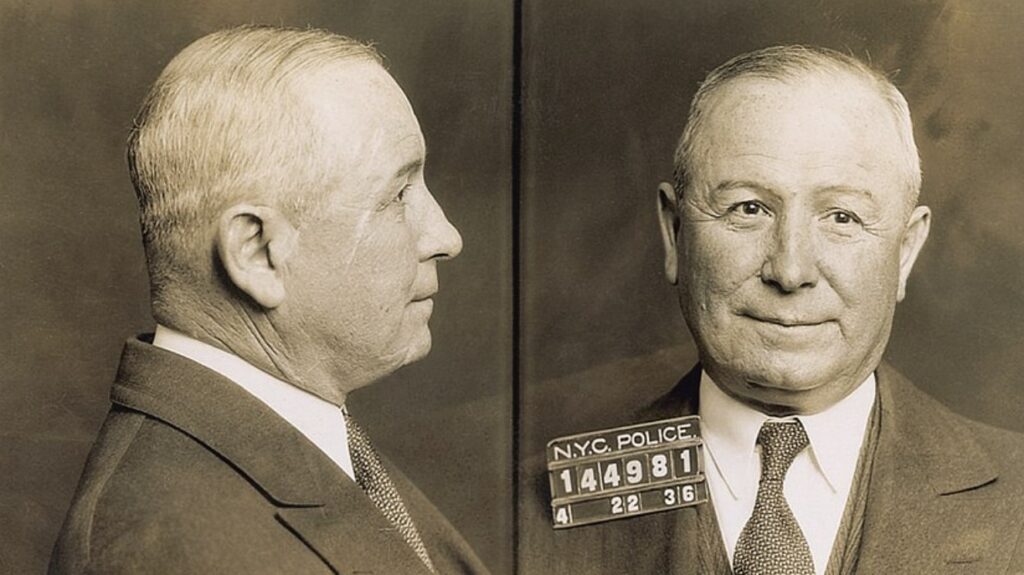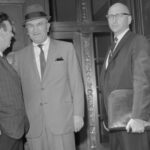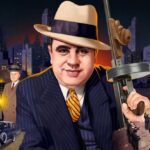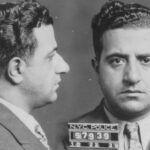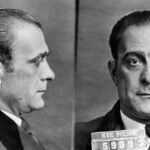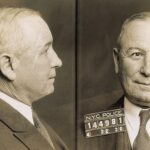In the heart of Italy, in 1882, a child named Johnny Torrio was born, destined to leave an indelible mark on the world of organized crime. The untimely death of his father set the wheels of fate in motion, leading Torrio and his mother to seek a new life across the ocean in New York City. The vibrant, chaotic energy of Manhattan’s Lower East Side in the late 19th century provided a fertile ground for Torrio’s initiation into the world of crime. It was here, amidst the teeming streets and the relentless hustle of city life, that Torrio first encountered the James Street Gang.
This gang, notorious in its own right, became the crucible in which Torrio’s latent leadership qualities were forged. The young Torrio, with his keen intellect and natural charisma, quickly distinguished himself from his peers. He didn’t just join the gang; he transformed it. Under his guidance, the James Street Gang evolved, expanding their operations and influence. Torrio’s early years were not just about survival; they were a masterclass in the art of street politics and power dynamics. His time with the gang laid the foundation for his future endeavors, teaching him valuable lessons about loyalty, strategy, and the importance of a well-calculated move.
The Mentorship of Paul Kelly and the Five Points Gang
As Torrio’s reputation grew, he caught the attention of Paul Kelly, the formidable leader of the Five Points Gang. This encounter marked a pivotal moment in Torrio’s life, as he transitioned from a street-savvy gang member to a sophisticated criminal under Kelly’s mentorship. Paul Kelly, a man of both charisma and notoriety, recognized Torrio’s potential and took him under his wing. This mentorship was more than just a criminal apprenticeship; it was a transformative experience that reshaped Torrio’s approach to organized crime.
Under Kelly’s guidance, Torrio learned the subtleties of managing a vast criminal network. He was introduced to the complexities of various illegal enterprises, from gambling dens to the nascent forms of racketeering. Kelly, a master strategist, imparted lessons that went beyond the mechanics of crime. He taught Torrio about the importance of maintaining a public facade, the art of negotiation, and the necessity of forging alliances. This period was a time of intense learning and growth for Torrio, as he absorbed the nuances of criminal leadership and strategy.
The mentorship also exposed Torrio to a broader criminal world, connecting him with influential figures and expanding his horizons beyond the neighborhood gang. This exposure was instrumental in shaping his vision of an organized crime syndicate, a vision that would later come to fruition in Chicago. The skills and connections Torrio gained during this time were invaluable, laying the groundwork for his rise to prominence in the criminal underworld. His time with Kelly and the Five Points Gang was not just a chapter in his life; it was the prologue to his legacy as one of the most influential figures in the history of organized crime.
The Chicago Chapter – Expansion and Empire Building
Johnny Torrio’s relocation to Chicago was not just a change of scenery; it was a strategic move that catapulted him into the upper echelons of organized crime. In the Windy City, under the shadow of the towering skyscrapers and amidst the bustling streets, Torrio found a new realm to conquer. His uncle, “Big Jim” Colosimo, a figure already deeply entrenched in the city’s underworld, provided Torrio with an initial foothold. However, it was Torrio’s own cunning and business savvy that enabled him to take full control of Colosimo’s operations, which spanned across various illicit activities including gambling and prostitution.
In Chicago, Torrio didn’t just take over an existing empire; he revolutionized it. He brought a new level of sophistication and organization to the operations he inherited. His approach was methodical and calculated, focusing on expanding the business while maintaining a low profile. Torrio’s ability to think strategically allowed him to identify new opportunities and areas for growth. He streamlined operations, established a hierarchy, and implemented systems that maximized efficiency and profits. Under his leadership, the operations grew exponentially, extending their reach across Chicago and beyond.
Prohibition and the Bootlegging Bonanza
The onset of Prohibition was a watershed moment in American history, and for Johnny Torrio, it was an opportunity of a lifetime. While many saw the new law as a restriction, Torrio saw it as a lucrative business opportunity. He was quick to recognize the public’s unceasing demand for alcohol and the immense profit potential in supplying it. This foresight placed him at the forefront of one of the most profitable ventures of the era: bootlegging.
Torrio’s venture into bootlegging was marked by both audacity and brilliance. He orchestrated the removal of his uncle, “Big Jim” Colosimo, who opposed the idea of bootlegging, in a move that was as ruthless as it was strategic. With Colosimo out of the picture, Torrio swiftly expanded into the bootlegging business. He set up a network for the production, distribution, and sale of illegal alcohol, turning the prohibition into a goldmine.
This expansion was not without its challenges. Torrio had to navigate a landscape rife with competition and danger. He established alliances, negotiated with rival gangs, and sometimes engaged in violent confrontations to protect his interests. His operations were a complex web of logistics and negotiations, involving everything from sourcing the alcohol to bribing officials to ensure smooth operations.
Under Torrio’s guidance, bootlegging became more than just selling illegal alcohol; it was a sophisticated operation that required careful planning and execution. He employed a variety of tactics to evade law enforcement and rival gangs, from using hidden speakeasies to employing trucks with secret compartments. The profits from bootlegging were astronomical, and they fueled the expansion of Torrio’s empire, consolidating his position as one of the most powerful and influential figures in the underworld of Chicago.
In these ventures, Torrio demonstrated not just criminal acumen but also a visionary approach to organized crime. He transformed the landscape of the underworld in Chicago, setting the stage for the city to become a central hub of organized crime in the United States. His impact on the criminal world was profound and long-lasting, with his methods and strategies becoming a blueprint for future generations of organized crime figures.
Al Capone – The Protégé Rises
In the annals of organized crime, few relationships have been as influential as that between Johnny Torrio and his protégé, Al Capone. Torrio, with his keen eye for talent and potential, saw something exceptional in the young Capone. This was not merely a mentor taking a novice under his wing; it was a visionary shaping the future of organized crime. Torrio introduced Capone to the intricacies of the criminal underworld, imparting wisdom and strategies that would later define Capone’s reign.
Capone’s rise under Torrio’s guidance was meteoric. He absorbed lessons not only in the operational aspects of the mob’s activities but also in the art of leadership and control. Torrio’s teachings went beyond the mechanics of crime; they delved into the psychology of power, the importance of public image, and the art of maintaining influence. Under Torrio’s mentorship, Capone developed a multifaceted understanding of the underworld, preparing him to take the reins of an empire.
This relationship was more than just a transfer of knowledge and power; it was a symbiotic partnership that reshaped the criminal landscape. Capone’s eventual takeover of Torrio’s empire was not a hostile coup but a natural progression, a testament to Torrio’s foresight in grooming a successor capable of leading the organization into a new era.
Rivalries and the Attempt on His Life
Johnny Torrio’s tenure at the helm of the Chicago underworld was marked by both triumphs and tribulations. His efforts to broker peace among the city’s rival gangs were a testament to his vision of a more organized, less chaotic criminal landscape. However, these efforts were often met with resistance, as entrenched interests and old animosities proved difficult to overcome. The most significant of these rivalries was with the North Side Gang, a formidable and relentless adversary.
The conflict with the North Side Gang was not just a clash of interests; it was a battle for supremacy in Chicago’s criminal underworld. The rivalry grew increasingly violent, culminating in a brazen assassination attempt on Torrio in 1925. This attack was a critical juncture in Torrio’s life and career. The experience of coming face to face with death had a profound impact on him, prompting a period of introspection and reassessment.
Surviving the assassination attempt was a turning point for Torrio. It led him to contemplate his legacy and the future of the empire he had built. This brush with mortality was a catalyst for change, influencing his decision to step back from the front lines of the mob and paving the way for Capone’s ascension. In this moment of vulnerability, Torrio demonstrated a rare quality among mob leaders: the ability to recognize when to step aside and allow a new leader to emerge. This decision not only altered the course of his life but also shaped the future of organized crime in Chicago and beyond.
Retirement and Advisory Role
The latter years of Johnny Torrio’s life were a stark contrast to his earlier days of direct involvement in the tumultuous world of organized crime. After surviving an assassination attempt and serving time for tax evasion, Torrio made a calculated decision to step away from the frontline of the criminal empire he had so meticulously built. This move to retire was not a retreat but a strategic repositioning. He passed the torch to Al Capone, ensuring the continuity of his criminal enterprise under a trusted and capable successor.
Torrio’s relocation to Italy with his wife was a significant shift, symbolizing a transition from an active mob boss to a sage advisor. However, the tranquility of retirement couldn’t diminish his influence in the criminal world. Torrio’s return to the United States marked a new phase in his life, where he assumed the role of an elder statesman in organized crime. In this capacity, he continued to wield considerable influence, offering counsel and guidance to a new generation of mobsters. His insights, drawn from decades of experience at the pinnacle of organized crime, were invaluable to those navigating the complex and often perilous underworld.
This advisory role underscored Torrio’s enduring impact on organized crime. He was not just a former leader; he was a mentor whose strategies and philosophies continued to shape the operations and structures of various criminal organizations. His ability to adapt and evolve, even in retirement, highlighted his unparalleled understanding of the dynamics of power and control in the criminal world.
Death and Legacy
Johnny Torrio’s passing in 1957 was more than the end of a life; it was the closing of a significant chapter in the history of American organized crime. His death from a heart attack brought an end to the career of one of the most influential figures in the underworld. However, the legacy he left behind was indelible. Torrio is often hailed as the architect of modern organized crime, a title that speaks to his innovative approach to criminal enterprise.
Torrio’s legacy is multifaceted. He was a visionary who transformed the disorganized and fragmented criminal activities of his early days into a structured, efficient, and far-reaching empire. His strategic thinking and organizational skills were ahead of his time, laying the groundwork for the future of organized crime. The systems and structures he implemented became a blueprint for criminal organizations worldwide.
Moreover, Torrio’s ability to adapt to changing circumstances, from the enforcement of Prohibition to the evolving landscape of law enforcement, set him apart as a leader who was not only reactive but also proactive in his strategies. His influence extended beyond his immediate circle, impacting generations of mobsters who looked to his methods and achievements as a guide.
In the annals of crime, Johnny Torrio’s name stands out not just for the empire he built but for the way he built it. His approach to organized crime was characterized by a blend of ruthlessness and intelligence, aggression, and astuteness. As a result, his influence continues to be felt long after his death, in the structures, strategies, and even the ethos of organized crime groups across the globe. Torrio’s life and career remain a testament to his extraordinary capabilities as a leader, strategist, and innovator in the world of organized crime.
The Enduring Impact of Johnny Torrio
Johnny Torrio’s life story is a testament to his impact on organized crime. From his humble beginnings in Italy to becoming a key figure in the Prohibition era, his journey is marked by strategic brilliance and adaptability. His mentorship of Al Capone and his role in shaping the Chicago Outfit are particularly noteworthy. Torrio’s strategies and organizational methods laid the groundwork for the modern structure of organized crime, making him an enduring figure in the annals of criminal history. His legacy continues to fascinate and inform our understanding of the complex world of organized crime.

